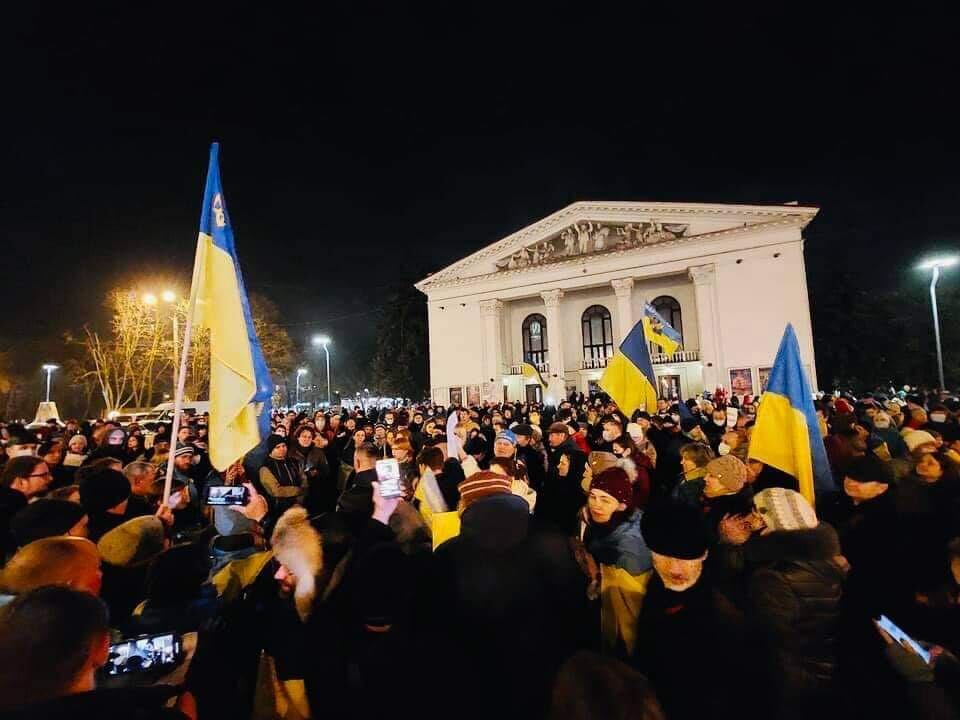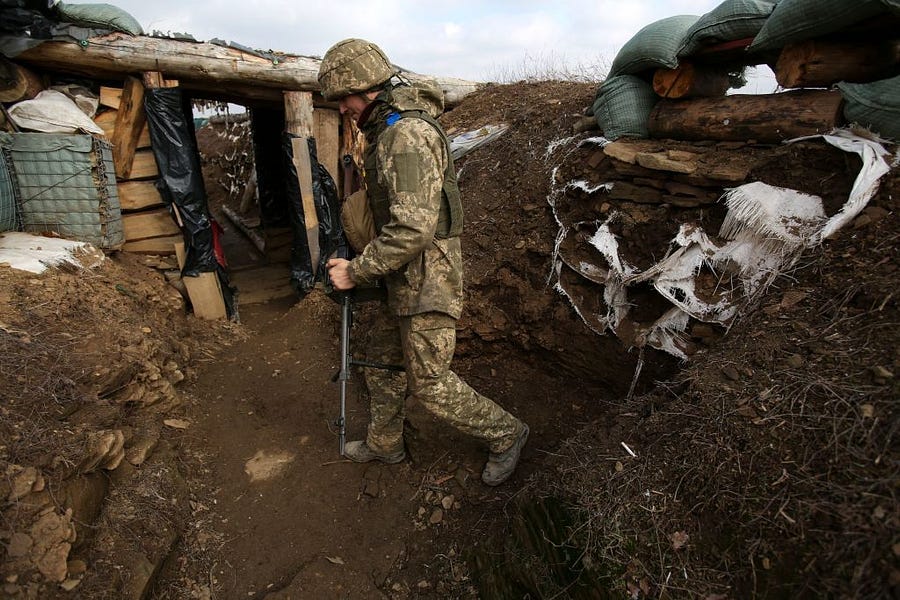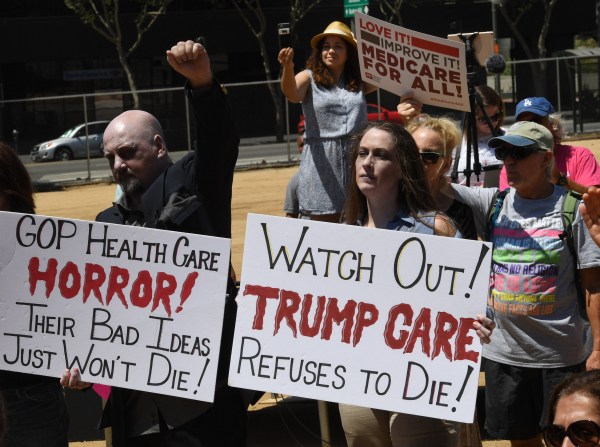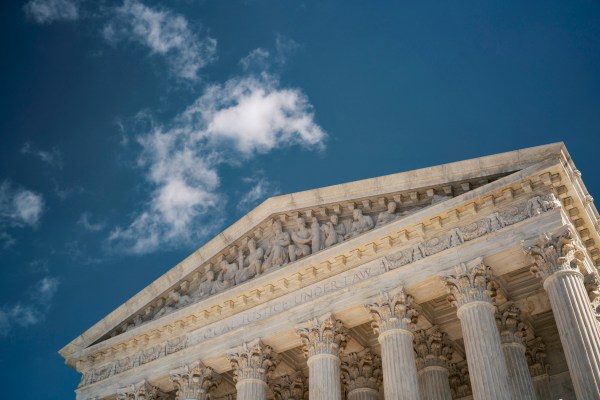Wednesday marked eight years to the day since President Viktor Yanukovych fled Ukraine following a mass uprising in the streets of Kyiv. The “Revolution of Dignity” unseated Yanukovych’s Kremlin-backed government, but not without a significant human toll. Police killed more than 100 protesters in the months-long demonstrations.
Now, in the midst of modern Russia’s latest and perhaps greatest threat to their sovereignty, Ukrainians are once again fighting back at great personal risk. In Mariupol—a city with recent knowledge of life under occupation—roughly 1,000 protesters gathered Tuesday to oppose President Vladimir Putin’s encroachment into eastern Ukraine.

Some of the demonstrators held signs; others waved their country’s blue and yellow national flag. Despite Russia’s deployment of troops into nearby Ukrainian territory less than 24 hours prior, calm prevailed. “There is no panic or helpless crying,” Ivan Syniepalov, a local translator, told The Dispatch. “Everyone who wanted to prepare himself has already done that.”
For three months, Ukrainians had watched as the Russian military concentrated more than 150,000 troops, fighter planes, missile systems, field hospitals, and naval vessels on its borders and coastlines with little to no response from the international community. So it came as little surprise on Monday when Putin delivered an hour-long address replete with conspiracy theories and revisionist history, eventually culminating in Russia’s recognition of the self-proclaimed Donetsk People’s Republic (DPR) and the Luhansk People’s Republic (LPR) on sovereign Ukrainian territory. Russian tanks rolled into the breakaway states in eastern Ukraine hours later.
But Kyiv and its partners in the West now fear Putin might push past the current frontline to make a play for cities and towns in the Donbas currently under Ukrainian government control. Or, in the worst-case scenario long forewarned by Western intelligence, that he might attempt to overthrow President Volodymyr Zelensky’s government and occupy Ukraine in its entirety.
In one of the slow motion crisis’s most concerning developments to date, Putin informed reporters on Tuesday that Russia recognizes both the DPR and LPR’s existing territorial holdings and claims to land now held by Kyiv. The expansionist interpretation of the republics’ “independence” signaled an explicit threat to the Ukrainian cities of Kramatorsk, Slovyansk, and Mariupol—each of which were at the center of fighting in 2014 and 2015—and other localities in the free Donbas.
Moscow’s recognition of the breakaways, which effectively scrapped the existing ceasefire agreement, coincided with continued efforts by Russia and its local proxies to create a pretext for further intervention.
On Monday, rebels in Donetsk claimed that the Ukrainian military had killed three people in a “terrorist attack” targeting civilians and infrastructure. On Tuesday, the LPR alleged that Ukrainian forces killed one of its fighters. As recently as Wednesday morning, the Luhansk-based group claimed that the detonation of several explosives near a bus depot “could lead to a large number of victims.” Russian media outlets quickly picked up and circulated each of these unverified reports—and numerous others in recent weeks.
Telegram channels operated by the rebel groups also shared sensationalized pictures and videos re-framing Ukrainian forces as the aggressors, priming viewers for escalation. In one, the LPR equates Ukraine’s military to Nazi invaders during World War II. Another features young children taking cover in bomb shelters to escape an alleged Ukrainian offensive. Meanwhile, Ukraine’s defense ministry has denied attacking the Donbas region in eastern Ukraine, prompting accusations that the breakaway republics either staged the attacks or bombed their own occupied territory.
Dmitry Khoroshilov, a member of the LPR’s unofficial parliament, demanded that Ukrainian forces withdraw voluntarily from the Donbas in a thinly veiled threat: “If this will not happen, I think a decision can be made that will allow establishing peace and restoring our territorial integrity throughout the entire territory of the Luhansk People’s Republic.”
And major shelling by the DPR and LPR in recent days, which killed two Ukrainian soldiers and wounded 18 others, has been interpreted by the Ukrainian government as an attempted provocation on the part of the Russians.
“I think they will try to cross the line of contact. They will try to expand the territories held by the so-called republics to their administrative borders,” said Iliya Kusa, an analyst at Kyiv-based Ukraine Institute for the Future. “This would include going further to seize such cities as Mariupol on the Azov Sea coast, which is a crucial city for Ukraine.”
On Tuesday, Zelensky announced plans to call up Ukraine’s reservists, which in total includes more than 900,000 troops, to train alongside its 200,000 active duty troops amid the Russian encroachment. At least 130,000 civilians in towns and cities across the country have also volunteered to fight in territorial defense units.
While eastern Ukrainians trust their armed forces, they fear what’s to come. “Our army is strong,” said Olexiy Ladyka, an eastern Ukraine-based journalist for the Kramatorsk Post. “[But] truly speaking a lot of people around me are scared. My colleague wrote … that she trembles with fear. It’s [a] difficult time for us. Maybe today is the last day without ‘big war,’ so I’m going to watch anime with my daughter. Maybe it will be the last time, who knows.”
With Russian forces still enveloping its borders from three directions, Ukraine continues to prepare for a scenario in which Moscow attempts to take the entire country by force.
U.S. President Joe Biden warned the world of such an effort in a speech on Tuesday. “We still believe that Russia is poised to go much further in launching a massive military attack against Ukraine. I hope I’m wrong about that—hope we’re wrong about that,” he said. “But Russia has only escalated its threat against the rest of Ukrainian territory, including major cities and including the capital city of Kyiv.”
The Russian president’s broad indictment of Ukrainian statehood on Monday left many viewers with cause for concern. In one instance, he alleged that Soviet Union founder Vladimir Lenin made a “mistake” as the “author and creator” of Ukraine. In another, he condemned Kyiv’s “rise of extreme nationalism, which quickly took the form of aggressive Russophobia and neo-Nazism.” Putin also seemed to mourn the end of Russian imperialism—though whether he was invoking Russia’s tsarist past or the Soviet Union is unclear.
“The speech itself was … something,” said Anton Barbashin, co-founder and editorial director at the Russia-focused media outlet Riddle. “It was probably the most aggressive of Putin speeches I’ve ever heard.”
Putin’s speech was surprising in its uncloaked rhetorical hostility toward Russia’s neighbor state, if not its content. The first 50-or-so minutes regurgitated the same arguments Putin made in his sweeping, 7,000-word revisionist history—“On the Historical Unity of Russians and Ukrainians”—published less than eight months prior.
But as has been the case since the buildup began in November, Putin couches his ethnonationalist ambitions in the language of national security. On Russia’s annual Defender of the Fatherland Day Wednesday, Putin said that while Moscow would like to see “diplomatic solutions” to its dispute with Ukraine, “the interests of Russia, the security of our citizens, are non-negotiable for us.”
Taken together with Western intelligence leaks, recent statements by other Russian officials denying Ukrainian sovereignty, and Moscow’s recent evacuation of its embassy and consulates in Ukraine, many fear that the Kremlin harbors plans to overthrow Kyiv’s government and return the country to its sphere of influence.
“Putin is trying to remake the Soviet Union by its hundredth anniversary,” an official with Ukraine’s security service told The Dispatch.
“I still think that this will be a massive invasion with a goal to get to Kyiv and it will start with artillery and airstrikes, followed by a ground invasion across three directions,” Dmitri Alperovitch, the Russian-born co-founder of Silverado Policy Accelerator and former chief technology officer of CrowdStrike, told The Dispatch. “The forces are all positioned, so the mobilization that we’ve been watching for many months now is complete. The forces actually moved to the border and are now in attack position, so they can really strike at any moment.”







Please note that we at The Dispatch hold ourselves, our work, and our commenters to a higher standard than other places on the internet. We welcome comments that foster genuine debate or discussion—including comments critical of us or our work—but responses that include ad hominem attacks on fellow Dispatch members or are intended to stoke fear and anger may be moderated.
With your membership, you only have the ability to comment on The Morning Dispatch articles. Consider upgrading to join the conversation everywhere.